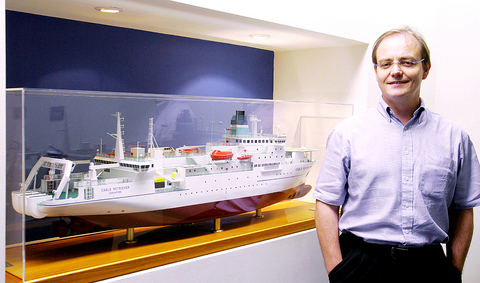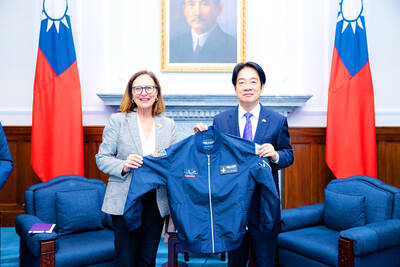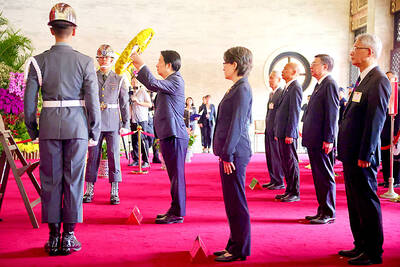Workers are relying on 19th century technology to fix a 21st century problem -- disruption of the Internet traffic that tech-savvy Asia relies on.
Crewmen on boats south of Taiwan are dragging the seabed with grappling hooks at the end of long ropes to recover fiber optic cables damaged in a 7.1-magnitude earthquake that struck the region on Dec. 26.
"No electronics involved," said John Walters, general manager of Global Marine, one of the firms engaged in the repairs. "It's an old and traditional technique."

PHOTO: AFP
Millions of people across the region in Taiwan, China, Hong Kong, Japan, Singapore, South Korea and as far away as Australia, suffered Internet and telephone blackouts when cables linking Asian countries with eachother and other regions were damaged.
Telecom operators have diverted the traffic to allow service to return to normal but the repair work continues.
"At this point none of those cables have been repaired," Walters told reporters in an interview.
"We are talking about cable that's lying on the surface of the seabed down to about 4,000 meters," Walters said.
Global Marine has two ships in the Bashi Channel and Luzon Strait between Taiwan and the Philippines, while other firms have provided four more ships, he said.
The vessels, specially designed to repair submarine cables, are more than 100m long and carry about 60 British officers and Filipino crewmen, he said.
They work 24 hours a day but the weather can hinder their progress. Walters said one ship is waiting for 48 to 64km per hour winds to die down in the Bashi Channel. The winds have stirred up 10 to 12m waves.
The second Global Marine vessel is closer to Taiwan and has been able to continue work, he said.
After arriving at the scene they survey the ocean bottom to assess whether the contour has changed, and the degree of sediment movement.
Then the traditional tools are brought out. A rope with a grapnel on the end is lowered into the depths and towed over the sea floor until tension registers on a graph on the ship, indicating contact has been made with the cable.
Today's fiber optic cables are just 21mm in diameter.
"You can understand the magnitude of the difficulty that we have," said Walters, who has 17 years' experience.
"What's key is the speed of the cable ship."
The grapnel is a metal tool about 46cm by 61cm with a cutter like a fine razor blade and a grabbing tool.
As tension increases and the cable is slowly pulled up, it is cut, grabbed, and half of it is hoisted to the surface.
Dropping the grapnel, dragging the sea bed and recovering the cable can take about 16 hours, Walters said.
"It is a tried and tested method," he said.
Once the severed half of the cable is on board the boat, debris is cleared from the damaged end and the cable is tested, sealed and its end boiled off. Then it is attached to a buoy on the water surface while the process is repeated for the second half of the cable before both halves are spliced together and dropped back to the ocean floor.
Even before the Boxing Day earthquake, Global Marine had faced a busy year, with about 20 repairs after damage from fishermen or anchors. All those ruptures were fixed using the old grapnel method, he said.
Global Marine has remotely operated vehicles, a type of underwater robot, but they cannot operate below a depth of about 2,000m and are usually employed to bury a repaired cable in shallower water, he said.
They are not quicker than grapnels, either.
"We've learned our lessons, if you like, from history," said Walters, whose UK-based firm traces its origins back to 1850, when the first international submarine cable was laid between Britain and France.
Grapnel design has evolved over the past century, giving operators a variety of tools to choose from depending on the underwater terrain, he said.
A single cable repair can take about seven days, but on this mission most operators are quoting a 10-day repair period, he said. With about eight separate cable systems in the waters off Taiwan, and close to 18 faults caused by the earthquake, repairs will take time.
"We anticipate that all of these systems should be repaired -- we're talking about end February," Walters said.

RESPONSE: The transit sends a message that China’s alignment with other countries would not deter the West from defending freedom of navigation, an academic said Canadian frigate the Ville de Quebec and Australian guided-missile destroyer the Brisbane transited the Taiwan Strait yesterday morning, the first time the two nations have conducted a joint freedom of navigation operation. The Canadian and Australian militaries did not immediately respond to requests for comment. The Ministry of National Defense declined to confirm the passage, saying only that Taiwan’s armed forces had deployed surveillance and reconnaissance assets, along with warships and combat aircraft, to safeguard security across the Strait. The two vessels were observed transiting northward along the eastern side of the Taiwan Strait’s median line, with Japan being their most likely destination,

‘NOT ALONE’: A Taiwan Strait war would disrupt global trade routes, and could spark a worldwide crisis, so a powerful US presence is needed as a deterrence, a US senator said US Senator Deb Fischer on Thursday urged her colleagues in the US Congress to deepen Washington’s cooperation with Taiwan and other Indo-Pacific partners to contain the global security threat from China. Fischer and other lawmakers recently returned from an official trip to the Indo-Pacific region, where they toured US military bases in Hawaii and Guam, and visited leaders, including President William Lai (賴清德). The trip underscored the reality that the world is undergoing turmoil, and maintaining a free and open Indo-Pacific region is crucial to the security interests of the US and its partners, she said. Her visit to Taiwan demonstrated ways the

GLOBAL ISSUE: If China annexes Taiwan, ‘it will not stop its expansion there, as it only becomes stronger and has more force to expand further,’ the president said China’s military and diplomatic expansion is not a sole issue for Taiwan, but one that risks world peace, President William Lai (賴清德) said yesterday, adding that Taiwan would stand with the alliance of democratic countries to preserve peace through deterrence. Lai made the remark in an exclusive interview with the Chinese-language Liberty Times (sister paper of the Taipei Times). “China is strategically pushing forward to change the international order,” Lai said, adding that China established the Asia Infrastructure Investment Bank, launched the Belt and Road Initiative, and pushed for yuan internationalization, because it wants to replace the democratic rules-based international

WAR’S END ANNIVERSARY: ‘Taiwan does not believe in commemorating peace by holding guns,’ the president said on social media after attending a morning ceremony Countries should uphold peace, and promote freedom and democracy, President William Lai (賴清德) said yesterday as Taiwan marked 80 years since the end of World War II and the Second Sino-Japanese War. Lai, Vice President Hsiao Bi-khim (蕭美琴) and other top officials in the morning attended a ceremony at the National Revolutionary Martyrs’ Shrine in Taipei’s Zhongshan District (中山) to honor those who sacrificed their lives in major battles. “Taiwanese are peace-loving. Taiwan does not believe in commemorating peace by holding guns,” Lai wrote on Facebook afterward, apparently to highlight the contrast with the military parade in Beijing marking the same anniversary. “We